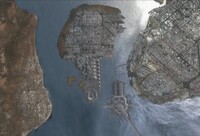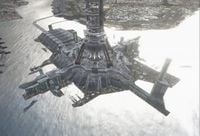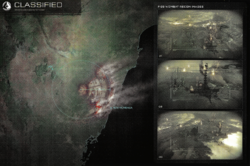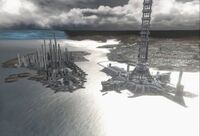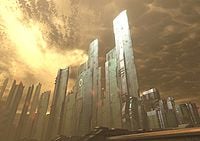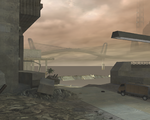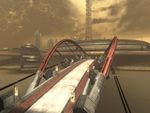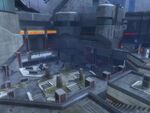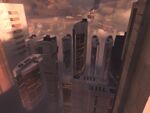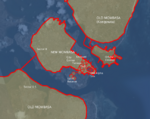User:CMDR RileySV/Sandbox
From Halopedia, the Halo wiki
| CMDR RileySV/Sandbox | |
|---|---|
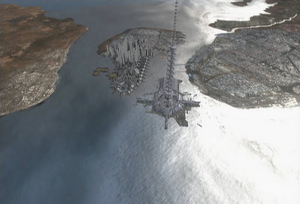
| |
| Overview | |
|
Location: |
|
|
Notable structure(s): |
|
Mombasa is a city in the Kenyan portion of the East African Protectorate on Earth. It consisted of a prosperous section called New Mombasa on an island known as Mombasa Island, as well as a run down section known as Old Mombasa, on the mainland around the island.[1]
History
The exact founding date of the city is unknown, but it has a long history. It must have been already a prosperous trading town in the 12th century, as one of its earliest mentions is from 1151. Mombasa had always been an important port of the Indian Ocean trade routes and was captured and recaptured countless times by a variety of powers including Portugal, the United Kingdom, and various Arab forces. This violent history led to its Swahili nickname "Kisiwa Cha Mvita," or "Island of War." The city became part of the independent nation of Kenya in the 20th century. During this era, Mombasa became a tourist destination, boasting numerous resorts and clean white beaches. It was also important as a port city, connecting East Africa to the Indian Ocean.[2]
The mainland districts were stifled, ironically, by their thirst for growth. During the 21st and 22nd centuries, sea levels worldwide began rising due to global warming. Port cities around the planet were faced with a choice: construct flood control measures, or drown. In Mombasa, it was decided that, rather than shore up the old docks on Mombasa Island, it would be easier to build brand new ports on the mainland, southwest of the city. So massive seawalls were built to hold back the rising waters, and new dock structures extended out into Kilindini Harbour.[citation needed]
Interstellar Era
For a time, these docks brought prosperity to the mainland. Shantytowns were demolished to make way for new office buildings, highways were constructed, and commerce thrived. But by the end of the 23rd century, global warming began to reverse as new technologies emerged and millions of people departed Earth for colonies in the rest of the Solar System. Sea levels began receding as temperatures dropped worldwide. In time, the port facilities on the mainland were left literally high and dry.[citation needed]
Mombasa underwent dramatic change with the arrival of the interstellar era. In response to increasing demand for cheap orbital access, due to its economic stability and prominent location, Mombasa was chosen to be Earth's first Space Elevator city.[3] The government began construction on one of the wonders of the age: a space elevator (Mombasa's proximity to the equator made it an ideal location) in 2302.[1] This structure served to lift heavy cargo into geosynchronous orbit without expensive booster rockets filled with fuel.
Over the next eleven years the city experienced explosive growth, but nothing compared to what followed. The city grew out as well as up, its urban sprawl unequaled throughout the continent.[1] There was an immediate influx of trade, people, and jobs; as a result, the landscape of the city was completely re-imagined. Within a century, the old apartment buildings and hotels on Mombasa Island had been torn down and replaced with the latest architecture, such as vast industrial complexes and gleaming office towers. It was during this period of tremendous growth that the city became known as "New Mombasa."
Mombasa would change dramatically within the centuries that followed. By 2430, New Mombasa had absorbed the entire island and many of the surrounding towns, which became overrun by residents of Mombasa. The switch of name was never official, and though many of the neighborhoods within direct line of sight to the Mombasa Tether still distributed newspapers and Chatter directories under their previous names, all municipalities within a 74 km radius of the island became referred to as "Old Mombasa."[1]
On December 19, 2512, the Superintendent was activated to manage the city's infrastructure.[4]
Covenant Invasion
- Main article: Battle of Mombasa
On October 20, 2552, a small group of Covenant capital ships arrived at Earth. Uninformed of the Human presence on Earth, Regret was outnumbered and outgunned against the UNSC Home Fleet. During the orbital battle, the Prophet of Regret's Flagship broke through Earth's defenses and descended to the atmosphere, and anchored itself above New Mombasa.[5] The Covenant started deploying their ground forces to the city, in search of a Forerunner relic, the Ark Portal, buried under the city.[6]
However, due to a strong UNSC counterattack and the inferior numbers of the Covenant, Regret ordered all of his forces to be evacuated back aboard the Carrier. After this, the ship jumped into slipspace just above the city, releasing a shockwave and pulling multiple city blocks from the mainland with it.[7] This event became known as the "New Mombasa Slipspace Event."[8] In the hours after Regret's retreat, a larger Covenant fleet arrived at Earth. After sending in ground forces and crushing the remaining UNSC resistance in the city, they glassed the area in order to uncover the Portal.[9] During the final days of the Battle for Earth, only smoldering ruins of Mombasa remained.[10]
Post-war
Following the end of the war, the Unified Earth Government began Project Rebirth to rehabilitate war torn areas on Earth.[11] At some point, the Project began in Mombasa. The old city hall thoroughfare for Mombasa was to be transformed into the UNSC Memorial Park.[12]
Government
The Superintendent, a second generation "dumb-AI,"[4] managed many of the municipal functions in New Mombasa[13] and in Old Mombasa.[14]
Transit
The transit of Mombasa is run by the New Mombasa Transit Authority. They are known to operate the extensive Maglev network within the city.[13][15] The city also runs buses and has extensive highway systems. These could all be run by the Transit Authority.
Highways and streets
|
Emergency
The New Mombasa Police Department is the police force of the city. They have stations in Old Mombasa[14] and their headquarters is located in New Mombasa.[16]
Waste Management
The waste management of the city is handled by the New Mombasa Waste Management. They operate all sorts of garbage cans throughout New Mombasa and presumably, Old Mombasa.[17] They also operate the Olifant.[9]
Parks and Recreation
The parks and greenspace of Mombasa are handled by the New Mombasa Parks and Recreation. They managed the Uplift Nature Reserve, and most likely the Kilindini Park Cultural Center.
Mail in New Mombasa was handled by the New Mombasa Post or NMPost.[13]
Economy
Corporations in City
- African Trust
- Lethbridge Industrial
- Hannibal Weapon Systems
- Jotun Heavy Industries
- Misriah Armory
- EnerGuide
- Franchbot Industries
- New Mombasa Uplift
- Vyrant Telecom
- AMG Transport Dynamics
- Cascade Stronghold Technologies
Culture
Media
Multiple media organizations exist within Mombasa. The city has two newspapers, the Daily Bulletin and The Mombasa Times.[14]
Architecture
The architecture of the city is different depending on the location. Old Mombasa's architecture was an odd hodgepodge of old and new: 16th-century Muslim arcades, aging 21st-century office buildings, looming 26th-century power couplings, old concrete homes secured with computerized locks. Clotheslines strung next to power lines, and mechanical gates set into ancient brick walls.[5][14] In some areas, newer skyscrapers had found their home.[9][18]
New Mombasa is composed differently. In some areas there is more use of a commercial focused arcology,[13] while in another, it is more focused on industrial design.[17]
People
The culture also seems displaced between the different parts of the city; while New Mombasa was populated with industrial workers and ambitious cosmopolitans, Old Mombasa was considered to be more of an old rundown slum that deteriorates by the day. The denizens of the old city were largely isolated from the residents of New Mombasa; even their dialect was completely different from the standard language.[6]
Other
Mombasa also had its own circus called the Mombasa Circus. As well, rock concerts were held in the city by bands such as Fluke of the Narwal.[14]
Geography
Mombasa Island, where the metropolis of New Mombasa lies, is separated from the mainland by two creeks: Tudor Creek to the north and Kilindini Harbour to the south. Northwest of the island and between the inlets, there used to be a large peninsula, connected to the Mombasa island by the Makupa Causeway.[note 1]
Old Mombasa
- Main article: Old Mombasa
The mainland area of Mombasa was known as Old Mombasa. By 2552, it had remained much the same as the preceding centuries.
Locations
New Mombasa
- Main article: New Mombasa
The futuristic metropolis of New Mombasa resided on the Mombasa island, connected to the mainland by multiple bridges. By the 26th century the city was a dynamic, cosmopolitan metropolis. Its buildings were sleek and sharp, with a multitude of interstellar corporations all owning property in the city center.
The City Center spans much of the Southeast portion of the island, being divided in multiple walled sectors.[note 2]
While the majority of New Mombasa has been divided to numbered sectors, some districts such as Mbaraki, Kizingo or Kikowani still retain their original names. The original names are often seen in the names of streets or train stations, for example. Some of the districts' names have changed, albeit slightly; areas originally referred to as Tangana and Liwatoni are now referred to as Tanaga and Liwitoni, respectively. The locations of some districts have changed as well. This is the case with most of the districts on the southern side of the island, where the sea has claimed large areas of land.[9]
Locations
Industrial zone |
|
Known Residents
- Sadie Endesha
- Daniel Endesha
- Mike Branley
- Roberto Bustamante
- Jim Odingo
- Marshall Glick
- Carlos Wambua
- Tom Uberti
- Melody Azikiwe
- Kinsler
- Jonas
- Stephen
- Communications Duty Officer
- Unnamed NMPD Officer
Gallery
Concept Art
- OM concept.png
Concept art of a street in Old Mombasa.
- Halo3-ODST EnvConcept-11.jpg
Concept art of the Orbital Elevator.
Old Mombasa
- Turf.PNG
A street in Old Mombasa.
New Mombasa
Mombasa area after the Battle of Mombasa.
Maps and Overviews
- Mombasa today.png
A satellite view of Mombasa during the 21st century.
Other
- 1225615107 Mombasabridge.JPG
The Mombasa Suspension bridge, shown to scale on Google Earth.
Notes
- ^ This landmass was shown, to be covered by water in Halo 3: ODST. This could be explained by the dramatic climbing of sea levels due to global warming, whose results are evident throughout Mombasa. Or by the creation of an artificial seaway that reaches further inland. It's also possible that this simply wasn't created for the in-game area as the only way to see that far west is only in Panoramic Camera Mode
- ^ In Sadie's Story, multiple areas seen in the ODST campaign are referred to as the city center. This includes Kikowani Station (Audio log 1, Circle 1, Arc 1), ONI Alpha Site and the New Mombasa Data Center (Audio log 8, Circle 3, Arc 2), the NMPD Headquarters (Audio log 24, Circle 8, Arc 3), and the area in which the Solemn Penance arrived at (Audio log 3, Circle 1, Arc 3).
Sources
- ^ a b c d Bungie.net: Field Guide entry: New Mombasa
- ^ Mombasa on Wikipedia
- ^ Halo Waypoint (Xbox 360 App): The Universe - Technology - Space Elevator
- ^ a b Halo Waypoint: Superintendent
- ^ a b Halo 2, campaign level, Outskirts
- ^ a b Halo Graphic Novel, "Second Sunrise Over New Mombasa"
- ^ Halo 2, campaign level, Metropolis
- ^ Halo 3, multiplayer map, High Ground
- ^ a b c d Halo 3: ODST, campaign level, Coastal Highway
- ^ Halo 3, campaign level, Tsavo Highway
- ^ Halo: Legacy of Onyx - Chapter 2, p. ???
- ^ McFarlane Toys/Halo Point Prizes - Bonus Item: Master Chief Statue Press Release
- ^ a b c d Halo 3: ODST, campaign level, Mombasa Streets
- ^ a b c d e Halo 2: Anniversary, campaign level, Outskirts
- ^ Halo 2, multiplayer map, Terminal
- ^ Halo 3: ODST, campaign level, NMPD HQ
- ^ a b Halo 2, campaign level, Metropolis
- ^ Halo: Reach, multiplayer map, Breakneck
| ||||||||||||||||||||||||||||||||
